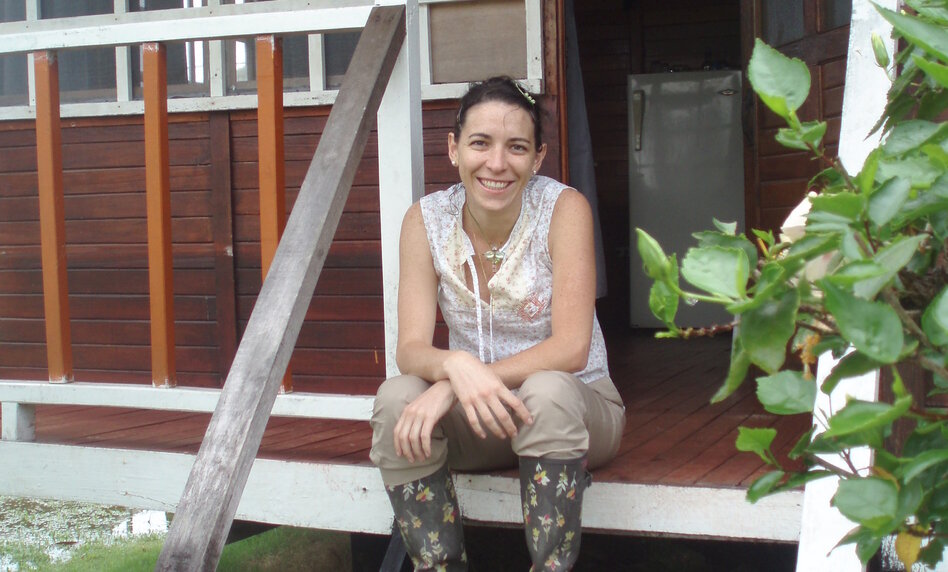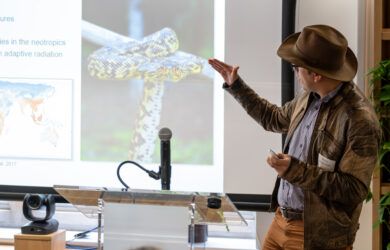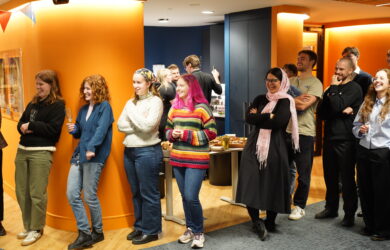
Carmen Lacambra Segura talks about her work on biodiversity and the need to balance nature's risks and benefits.
We need to inform people about climate change, but also understand local contexts and not expect one solution to fix everything. Building with people from the ground up leads to solid and sustainable initiatives
Carmen Lacambra Segura
Carmen Lacambra Segura is keen to tackle the challenges affecting biodiversity from an interdisciplinary perspective which takes into account all the different factors that affect it. That means taking more contextualised approaches and using data to make positive progress.
She has worked for over 30 years on resilience and climate adaptation, integrating science and evidence-based practices into her work and has contributed to two Intergovernmental Panel on Climate Change reports. Carmen [2005] is Director of Research & Environmental Services for the Colombia-based consultancy Grupo Laera, which she co-founded in 2011 with her two brothers. Her approach is in part about reinforcing ecosystems, communities and systems resilience, including adaptation and resilience metrics and evaluation. Laera works with artesanal fishers, smallholders, SMES, large enterprises, governments and world-leading organisations addressing climate adaptation and other global challenges with local action, science, policy and private and public sector initiatives.
Background
Carmen was born in Bogota, Colombia, and studied Biology at the Universidad de Los Andes. Her five-year course involved research in different ecosystems, from the jungle to the desert as well as a survival course in the wilderness where she had to learn how to light a fire with her bare hands. On graduation she studied the habitat of river dolphins in the Arauca river (Orinoco basin) and after working with the Navy as a contractor, she did a master’s course at the University of Hull in coastal zone management and worked as a coastal ecologist.
She then returned to Colombia, via Africa, to work at INVEMAR, the Marine and Coastal Research Institute before eventually ending up at Cambridge, as a Chevening Scholar with UNEP-WCMC and then as a Gates Cambridge Scholar for her PhD in Geography under the supervision of Professor Tom Spencer and Professor Iris Möller. Her PhD tracked how coastal zones in the tropical Americas have changed in line with extreme events, including hurricanes and tsunamis and how coastal ecosystems have responded to those events. At Cambridge she also took part in a Judge Business School programme on entrepreneurship which led eventually to her co-founding Grupo Laera. As part of her PhD she was also part of the peer-support programme run by the Department of Psychology which she says gave her life-long tools for improving listening and communication skills with vulnerable populations.
Covid and beyond
The last few years since the Covid pandemic have been eventful for Carmen. Grupo Laera contracted to three members of staff due to the pandemic, but has since built back up to 11, including four data scientists, showing the increasing importance of data in the field. Everything went online too and Carmen wasn’t able to travel physically to sites to help design and evaluate projects. While clients liked the efficiency that this offered, Carmen says she feels it is harder to get a sense of the full context of a project without being able to speak to the local community on the ground. Things are changing again now, however, and returning to what they were like before the pandemic.
Grupo Laera has been supporting a women-led institution (América – Vedrunas) focused on education and social wellbeing for vulnerable populations in 12 countries across the Americas. The institution, which operates 18 educational and health centres, is working with students who these days have less of a religious vocation but more of an interest in social and environmental issues. Carmen says: “Our goal is to strengthen this evolution, ensuring that its positive impact continues and expands, reaching new generations committed to social change and environmental sustainability.”
The Laera team has also expanded to provide AI services for risk assessment in the financial sector. She states that AI can predict financial risk but contains a high level of uncertainty, even where there is a lot of data. When it comes to the environment, including climate, there are so many variables. For example, although good data exists for some regions in the world, it is hard to come by in others and, although models are improving, including all the variables affecting one place is still a challenge.
Carmen adds that, since the publication of the Millenium Ecosystem Assessment (which she participated in), our understanding of the benefits of nature to humanity, underpinned by science, has increased dramatically, as has the amount of people working in the sector. Yet that contribution to wellbeing, reducing risk, providing water and food and many other benefits, including nature-based solutions, is hard to measure. Fisheries, for instance, depend on mangroves that also store carbon, protect the coasts, provide materials for dyes, store nutrients and provide timber, among many other advantages. However, it is difficult to place a monetary value on mangroves because this would have to be mapped over a long period of time and because not all the benefits they offer are used by all communities and/or provided by all mangroves.
In the Amazon, she adds, there has been a lot of focus on carbon emissions and less on the jungle’s role in climate regulation and water production for most of South America as well as its relevance to the world generally. If we focus only on one aspect, despite its relevance, it is highly likely, says Carmen, that we will miss other benefits that may be more immediate for local people. In coastal cities, for instance, ecosystems (mangroves, corals, salt marshes and sand dunes) can protect cities from coastal erosion and extreme events; along the Andes ecosystems (such as cloud forests and wetlands) provide water.
Carmen says another challenge is that climate change and biodiversity have become very political and tend to be focused on the negative and on blame. She thinks we need to move to a more positive narrative, one which understands the different pressures people are responding to and which is not so full of despair. She states: “I am not saying that there are not problems we need to resolve now before it is too late. It is the way the message is often delivered and who is delivering it, as well as the science underpinning the message, that are also very important.”
Project work
One big EU-funded project Carmen has been working on – which has brought her back into contact with Cambridge academics, including Professor Möller – is the NATURESCAPES research project which looks at urban landscapes in 30 cities mainly in Europe and the Americas and at how nature provides solutions, trade-offs and synergies. The project started a year ago. Carmen describes it as very multi-disciplinary, bringing together social scientists, geomorphologists and ecologists. “We are trying to understand the science, the processes and perspectives of different people and how, through different tools, we can create urban societies which are more aligned with nature,” she says.
“Most of my work centres around how nature can be useful for human wellbeing. That involves both understanding nature and understanding what we don’t know about it.”
It also involves understanding the trade-offs between, for instance, restoring wetland and restoring a habitat that could become a breeding ground for dengue or malaria, depending on location. “There are synergies and trade-offs involved with promoting biodiversity in cities,” says Carmen. “Nature does a lot of amazing things, but there is a reason why we have decided to protect ourselves from it.”
She adds: “Something we do to boost biodiversity in London may mean one thing, but in the Tropics it may mean something else,” she says. “In London we are not creating a habitat for snakes and poisonous frogs. In tropical settings we must think about the habitats we might be creating for certain animals and how these may spread disease as more and more cities encroach into very biodiversity-rich areas. If we understand these risks we can plan better for them. Part of living with nature is accepting nature’s many benefits while considering as well its potential risks so that safeguards can be put in place and risks can be reduced. We also need to accept that not everyone wants to be surrounded by nature.”
Carmen has also just finished another project on how to bring about sustainable economic growth in remote areas of Colombia in a changing climate. It was a welcome opportunity for her to travel back to areas of her home country that she hasn’t visited for decades. Carmen spoke to local people to understand their context and what they needed. “I didn’t meet anyone who hated nature or didn’t believe in climate change, but they have other priorities. They have lived with climate variability and responded to hazards, but for them there are other things that are more urgent,” she says, although she notes that the young in particular are more worried about environmental degradation, deforestation and the consequent lack of water.
Carmen has observed that there are certain funders who are trying to pay communities to divert them away from cutting down forests to grow coca, but she says that they sometimes fail to understand the realities of life in some regions of the world. She believes in a more interdisciplinary approach to the issues based on the reality on the ground and in presenting a more optimistic narrative. “We need to inform people about climate change, but also understand local contexts and not expect one solution to fix everything. Building with people from the ground up leads to solid and sustainable initiatives,” she says.
Carmen is now gearing up for the COP 16 which takes place in Cali from October 21st, where she hopes a more solid biodiversity monitoring framework will be presented and that the Global South can showcase the successes it has achieved and how adequate financial mechanisms could reap greater returns.












